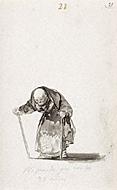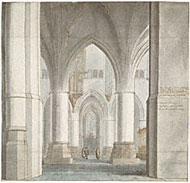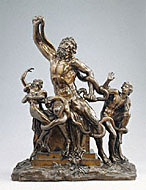Real space is three-dimensional. Space in a work of art refers to a feeling of depth or three dimensions. It can also refer to the artist's use of the area within the picture plane. The area around the primary objects in a work of art is known as negative space, while the space occupied by the primary objects is known as positive space.
Positive and negative space
The relationship of positive to negative space can greatly affect the impact of a work of art. In this drawing, the man and his shadow occupy the positive space, while the white space surrounding him is the negative space. The disproportionate amount of negative space accentuates the figure's vulnerability and isolation.

He Can No Longer at the Age of 98, Francisco José de Goya y Lucientes, 1819–1823
Three-dimensional space
The perfect illusion of three-dimensional space in a two-dimensional work of art is something that many artists, such as Pieter Saenredam, labored to achieve. The illusion of space is achieved through perspective drawing techniques and shading.

Saint Bavo, Haarlem, Pieter Jansz. Saenredam, 1634
From the J. Paul Getty Museum:
https://www.getty.edu/education/teachers/building_lessons/formal_analysis.html
Balance is the distribution of the visual weight of objects, colors, textures, and space. If the design was a scale, these elements should be balanced to make a design feel stable.

Madonna, Saint Thomas Aquinas, and Saint Paul, Bernardo Daddi, about 1330
Symmetrical balance conveys a sense of stability. In this example, a single large figure in the center is flanked by a smaller figure on either side. The shape of the artwork itself is also symmetrical—a vertical line bisecting the image would create two equal halves that are mirror images of one another.

Wall Clock, French, 1735–1740
Asymmetrical balance often conveys a sense of movement since the elements of the composition are unbalanced. In this example, the artist used organic forms to create a composition that mimics the movement of vines growing in an unordered fashion around the clock face.
Emphasis is the part of the design that catches the viewer's attention. Usually the artist will make one area stand out by contrasting it with other areas. The area could be different in size, color, texture, shape, etc.

Laocoön, Giovanni Battista Foggini, about 1720
In this sculpture, the central figure stands out due to his relative size and position above the other figures. The diagonal lines of the contorting bodies and the serpent lead the viewer's eye to the figure, further emphasizing him and conveying the intensity of his struggle against the snake's stranglehold.
From the J. Paul Getty Museum:
https://www.getty.edu/education/teachers/building_lessons/formal_analysis2.html
